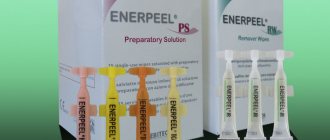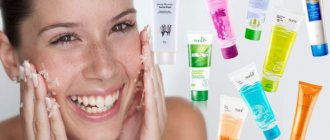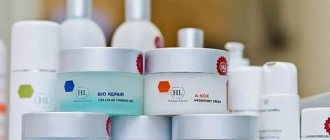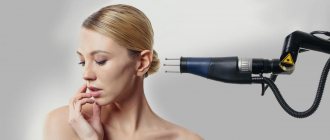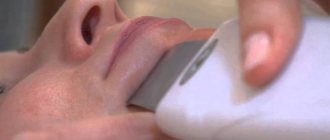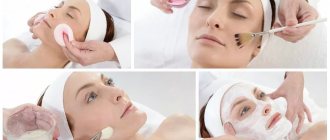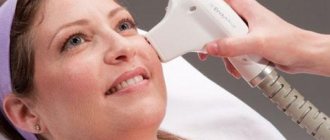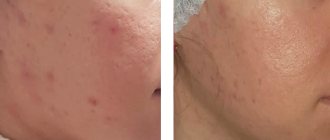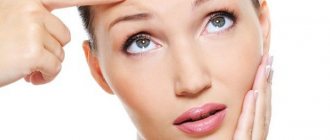Chemical peeling is a facial cleansing procedure by removing the top layers of skin, the epidermis. Chemical peeling allows you to solve many facial skin care issues in just one procedure - it is most effective and convenient for women of any age. Chemical peeling is done using various acids that penetrate the epidermis and remove surface skin particles. With the help of chemical peeling, you can get rid of wrinkles, excessive skin pigmentation, acne, potholes and pits of various origins in the shortest possible time - the effect will be immediate, but a certain recovery period will be required to evaluate the result.
For the chemical peeling procedure, phenol, glycolic, salicylic or trichloroacetic acid, as well as lactic and fruit acids are used - each substance is intended for its own type of cleaning. Chemical peeling is effective at any age, but it is recommended not to carry out the procedure too often - read more about this in the blocks on superficial, medium and deep facial cleansing.
Pros and cons of chemical peeling?
Chemical peeling is a procedure for introducing active acids under the skin to destroy outdated layers of skin. By renewing, skin cells acquire a more youthful appearance, which also helps eliminate skin defects, including age-related wrinkles. The basic rule when using chemical peeling is this: you can only get help in restoring your skin in specialized clinics. Do not try to find a cheap option for the procedure; high-quality chemical peeling cannot be cheap - this is a complex medical and cosmetic procedure that must be performed by an experienced doctor.
Unlike most facial skin care cosmetics, chemical peeling has an immediate effect; in addition, the procedure is useful: regular renewal of the surface particles of the skin will keep the skin youthful and healthy in appearance for much longer.
Many women prefer cosmetics to chemical peeling for the face, but these are different things: the procedure can be performed in parallel with the use of creams, masks and other products - this will achieve a more pronounced effect.
What is facial peeling
Peeling is a procedure aimed at removing the top layer of epidermal cells. As a result of its implementation:
- Skin pores are cleansed;
- Mechanisms of intensive cell renewal are launched;
- By improving blood flow, the process of saturating cells with nutrients is stimulated;
- Wrinkles become less pronounced;
- The complexion becomes fresher and more even.
There are many types of peeling. The choice of a specific option depends on what kind of effect you need and what problem you are solving with this procedure.
Facial peels have the following effects:
- Exfoliating;
- Moisturizing;
- Anti-inflammatory;
- Antioxidant;
- Strengthening the synthesis of glycosaminoglycans, collagen and ceramides.
Types of cleaning
Facial peeling can be of three types:
- surface;
- median;
- deep.
In each case, the chemical peeling procedure has its own characteristic features; in addition, different types of cleansing solve different types of problems characteristic of different age groups. Due to the introduction of active acids, complete exfoliation of the upper layers of the skin occurs, which leads to stimulation of the natural process of rejuvenation of the skin. This way, the active production of new cells and the production of hyaluronic acid are stimulated, the procedure also triggers natural protective mechanisms - this makes the skin more toned, youthful and clean.
Surface
When compared with all existing varieties, the superficial facial peeling procedure can be confidently called the safest and fastest. Despite this, this method of cleaning the upper layers of the skin is effective, it is ideal for starting active skin care.
As the main active ingredient, as we said earlier, the chemical method of removing the epidermis and rejuvenating the skin, that is, facial peeling, involves the use of acids. Superficial peeling uses fruit and lactic acids, or it can also be a weak solution of trichloroacetic acid. These are low-active acids that penetrate only the upper layers of the skin and are not capable of causing harm to the body.
Benefits of superficial facial peeling.
- Relieves acne and seborrheic manifestations, removes inflammation and redness. In simple words, this is cleansing the skin of unpleasant defects and its comprehensive rejuvenation.
- Removes flaky skin and small freckles.
- It is safe and painless, many patients even report pleasant sensations during the procedure. Such peeling, although it involves a chemical method of action, is unlikely to cause complications.
- Does not require preliminary preparation in the form of applying special softening agents and mechanical cleaning of the skin.
- There is no recovery period, the effect will be noticeable immediately after the procedure - when you get up from your chair, you will already enjoy the impressive result.
- It does not change skin tone, which means the procedure can be performed even on those with darker tones.
As you can see, this peeling is ideal for the first time, the skin of the face will be completely cleansed, and you will become familiar with how the chemical method of exposure can improve your appearance and maintain youth.
Among the disadvantages of superficial facial cleansing: it does not eliminate deep skin problems and does not remove wrinkles. In addition, the ideal result will be noticeable only after the 5th or even 6th procedure.
The superficial type of chemical peeling is recommended for women under the age of forty; it is recommended to do it no more than once a month. The duration of the procedure is approximately 20 minutes.
Median
This chemical method of influencing the surface layers of the skin is no longer so safe, however, peeling is carried out mainly without anesthesia; it will take at least 2 days for facial skin to recover after the procedure.
This type of chemical facial peeling already allows you to get rid of wrinkles, including deep senile wrinkles. The main active ingredient is either a solution of trichloroacetic acid, or almost pure glycolic or salicylic acid.
Benefits of medium facial peeling.
- Allows you to get rid of extensive pigment manifestations, as well as all small freckles.
- It is practically painless and at the same time has an impressive effect. In some cases, medium chemical facial peeling is performed under local anesthesia, because during the procedure patients may experience an unpleasant burning sensation and tightness of the skin.
- Effectively eliminates fine, medium and some deep wrinkles. Medium facial peeling is more popular than superficial chemical cleansing precisely due to this effect.
- Improves facial tone and color: the skin becomes more toned, sagging and flabbiness disappear, and the tone is evened out. The procedure can give the skin a slight glossy glow, which disappears over time.
Of the minuses: preparation is required in the form of applying special softening substances, it may be a little painful, the complexion will most likely become lighter. In addition, the high price of the procedure often discourages many women from undergoing it.
The superficial type of chemical peeling is recommended for women over the age of thirty. The procedure should not be carried out more often than once every six months. The average duration of medical and cosmetic procedures is 40 minutes.
Deep
This is the most radical method of chemical peeling of the face. It is based on the use of phenol, a toxic substance that penetrates deep into the skin, where it destroys the old layer of the epidermis and triggers the extensive formation of new cells.
Benefits of deep facial peeling.
- Completely eliminates wrinkles, including deep senile wrinkles in just one session.
- Corrects the smoothness of the face, allowing you to get rid of even deep skin irregularities.
- Eliminates freckles, age spots and other manifestations of strong pigmentation.
- It is the most effective skin cleansing method that exists today.
- The effect of undergoing the procedure will be radical and will last for at least several years.
But everything can’t be all good, as doctors say, so it’s worth considering the disadvantages of such a radical method of facial cleansing.
- It is very painful, so it is always performed under local anesthesia; in some cases, doctors resort to sedation.
- Involves a long recovery period: from two weeks to one and a half months.
- The result of the procedure will be noticeable only after the recovery period, which in most cases is accompanied by pain, redness and the formation of a hard crust.
- As a result of such radical facial cleansing, the skin will become significantly lighter, which means deep peeling is not suitable for girls with dark skin.
- The cost of the procedure is high, but this is more of a plus than a minus - this way there will be no temptation to carry out the procedure too often.
A deep type of chemical peeling is recommended for women over the age of forty. The procedure is carried out once every 2-3 years. The average duration of medical and cosmetic procedures is one hour.
How does facial skin behave after peeling?
Superficial peeling gently cleanses the skin of protein impurities and skin secretions, and separates dead cells that interfere with the free access of oxygen. As a result, the facial skin after peeling acquires a radiant color, a uniform tone, becomes more elastic, the first small wrinkles are smoothed out, and the pores are narrowed.
This effect is greatly enhanced and lasts longer if the procedure is done in a salon or cosmetology clinic. Professional preparations contain a whole range of balanced components for healthy skin, which cannot be said about peelings for home use.
Advantages of superficial peeling:
• More gentle effects than deep chemical peeling or laser resurfacing; • Absence of pronounced peeling and rehabilitation period; • Possibility to use at any time of the year, even in summer; • Suitable for any age and any skin type without exception; • Strengthens and prolongs the effect of other cosmetic products and manipulations.
The Epilike network of clinics offers high-quality cosmetic peelings and Finepeel laser peeling using the Clear+Brilliant device.
Effect of chemical peeling
The chemical peeling procedure involves the injection of active acids under the skin, while the patient is in a beauty salon in a special chair. Depending on the depth of cleaning, facial peeling may require anesthesia and even sedation - putting the patient into a semi-asleep state, similar to mild anesthesia.
The peculiarity of chemical peeling is that it is only suitable for delicate skin, which tends to form a large layer of epidermis. Thus, peeling, which involves a chemical method of action, can only be used to clean the skin of the face, neck and décolleté.
Selection of peeling
When choosing a peeling, we will rely on the following criteria :
- The concentration of active ingredients, that is, the percentage of acid input (the higher the concentration of chemical agents, the stronger the peeling effect and the higher the result, but at the same time the irritating ability also increases).
- Peeling pH. This indicator is often forgotten, but a change of just 0.5 can radically change the skin's response. For example, glycolic peeling with pH 2.5, when applied correctly, will provoke a gentle exfoliation of horny scales, lightening of pigmentation, stimulate the division of keratinocytes and enhance metabolic processes in the skin. However, glycolic peeling with pH 2.0 is no longer recommended for patients with subtype 1 rosacea, as it will provoke a vascular reaction.
- Peeling texture: gel or in the form of a solution (water-alcohol). With gel, the depth of penetration depends on the exposure time, penetration is slow, and, accordingly, there is less skin irritation. Before neutralization, it must be washed off with water. With aqueous-alcoholic, the depth of penetration depends on the number of layers applied; it is necessary to wait for each layer to dry and very carefully monitor the skin reaction; if bright erythema or frost appears, immediately neutralize it.
The depth of chemical peeling and the number of procedures are selected individually by a cosmetologist or dermatologist and directly depend on the patient’s health (carefully collected medical history), age, skin condition and phototype. Recently, special attention has also been paid to profession and lifestyle, which is associated with possible rehabilitation (peeling, redness, the appearance of a feeling of “tightening”, etc.).
Indications for facial cleansing with chemical peeling
As such, there are no medical indications for the procedure, because it is cosmetic and not medical. But it’s very simple to list the problems that chemical facial peeling solves:
- any kind of pigmentation, both acquired and congenital;
- seborrheic manifestations;
- acne;
- fine, medium and deep wrinkles;
- skin irregularities;
- pimples and blackheads;
- potholes on the surface of the skin and much more.
In simple terms, chemical peeling for the face is effective for any cosmetic problems, as well as age-related changes in the skin.
Indications and contraindications for peelings
Our skin is constantly exposed to ultraviolet radiation, high and low temperatures, dusty and polluted air, and various cosmetics. As a result, it fades, loses moisture, pigmentation, and the production of collagen and elastin fibers are disrupted. As a result, premature aging occurs.
In this case, peeling will come to the rescue. It helps fight:
- dull complexion;
- “stressed” skin;
- decreased elasticity;
- premature signs of aging (fine superficial wrinkles);
- pigmentation disorders;
- inflammatory rashes;
- post-inflammatory pigmentation;
- scars after acne.
These problems are familiar not only to women. Peels are recommended for everyone, regardless of gender and over 18 years of age.
The following contraindications will limit the procedure:
- pregnancy and breastfeeding;
- herpes in the acute stage;
- ARVI;
- increased body temperature;
- damage to the epidermis (manifestation of active pustular rash, burns, abrasions, inflammation, etc.);
- period of high solar activity;
- intolerance to the components of the drug.
Contraindications
The procedure for chemical facial cleansing cannot be performed for the following diseases:
- dermatitis;
- neurodermatitis;
- psoriasis;
- cancer diseases;
- keloid and hypertrophic scars;
- fresh wounds, including open injuries;
- cuts and scratches on the skin;
- purulent inflammatory processes;
- pronounced allergic reactions;
- individual pathological reactions to chemical drugs.
In all these cases and many others, chemical peeling (especially deep) is contraindicated. Even in the absence of visible contraindications, it is necessary to consult a dermatologist before performing the procedure!
Contraindications and side effects
Contraindications include the following:
- infectious diseases,
- exacerbation of skin diseases,
- neoplasms,
- warts,
- pathology of the thyroid gland,
- skin damage,
- herpes in active form,
- allergies and hypersensitivity,
- tendency to form keloid scars,
- taking Roaccutane no earlier than 6 months. before the procedure,
- pregnancy and lactation,
- childhood.
Side effects may include hyperpigmentation, swelling, redness, blistering and itching.
In rare cases, more serious complications occur: persistent swelling (more than 48 hours), persistent redness of the skin, hyperkeratosis, atrophic changes in the skin, milia, scars, the appearance of a visible border of the areas subjected to peeling.
To reduce the risk of side effects, the procedure must be performed in a licensed cosmetology center, with highly qualified and experienced specialists.
By clicking “Submit”, you consent to the processing of your personal data in accordance with Federal Law No. 152-FZ “On Personal Data” and accept the terms of the User Agreement
Photos BEFORE and AFTER peeling
Reviews
Like any cosmetic procedure, chemical peeling can satisfy the needs of women in different ways - we suggest you familiarize yourself with the main types of reviews from patients of the clinic.
* * * * *
Alexandra
06.03.2018 12:20
The first time I carried out superficial cleaning on the advice of a friend, I was very afraid, so I consulted two dermatologists in advance about the safety of the procedure. It all passed quite quickly, I felt nothing. The effect far exceeded expectations: better than the strongest masks, and lasted longer. Now I do this cleaning about three times a year.
* * * * *
Elizabeth
22.02.2018 14:11
With age, wrinkles became very noticeable, so without much thought I decided to undergo a radical cleansing. Since I had never performed such procedures before, it was quite unpleasant even with anesthesia, but it all went away quite quickly. I spent my winter vacation completely at home, that’s 3 weeks. The clinic said that in the summer they don’t do deep peeling at all because it’s very dangerous. I was more than pleased with the result, but for a very long time I could not get rid of the unusual feeling of tightness that remained after the procedure - it went away on its own after a month and a half.
* * * * *
Angela
17.11.2017 17:36
I chose the middle cleaning, everything was done quickly and efficiently, I didn’t feel any pain. Compared to any creams and masks, peeling is much more effective, it’s impossible to even compare. I haven’t thought about repeating the procedure yet, everything suits me.
What types of peelings are there?
Peels can be divided according to different criteria:
- Penetration depth: superficial, middle, deep. If the superficial ones work only at the level of the stratum corneum, without affecting living cells, then the deep ones already work with the entire epidermis and dermis.
- By method of implementation: chemical, mechanical, hardware, ultrasonic, laser.
Within each category there are many options, it is almost impossible to choose from on your own. In addition, a peeling chosen only by name or description can be harmful: the necessary procedure should be determined by a cosmetologist who will take into account all the features of your skin, its needs and risks. But this does not mean that you should not know the details of the procedure. We have collected information about the most popular peelings that you can do in our clinic.
How does acid affect the skin?
Acids used for chemical exfoliation are:
- Fruit or A-acids (Alpha hydroxy acids) - quickly exfoliate dead skin particles, have an antioxidant effect, normalize moisture and pH levels, and block the proliferation of pathogenic microorganisms. They affect the skin at the tissue, cellular and molecular level. These include: lactic, mandelic, glycolic, tartaric acid. Alpha acids are soluble in water.
- B-acids (Beta-hydroxy acids) - affect the functioning of the sebaceous glands, control sebum production and remove enlarged pores. Actively fight bacteria, dissolve fats and dirt. These include salicylic, malic, and citric acid. Beta acids are fat soluble.
- Polyhydroxy acids (PHAs) are a new generation of products that have the same effect as AHAs, but with a more gentle effect. Suitable even for very sensitive skin prone to allergic reactions. These include gluconolactone and lactobionic acid.
Separately on the list is azelaic acid, which has bacteriostatic activity against staphylococcus and propionobacteria. Suppresses the growth of pathological melanocytes, fights hyperpigmentation, acne and comedones.
Upon contact with the skin, the substances included in the peeling agent dissolve epidermal cells. In case of a chemical burn, restoration and regeneration processes are activated. The growth of fibroblasts is triggered, which promotes increased production of collagen and elastin fibers, and the synthesis of hyaluronic acid is stimulated. The cells of the basal layer begin to divide faster, as a result, abnormal and dead particles are replaced by young, renewed ones, with a high content of the moisture factor. The skin becomes homogeneous, the pores are cleaned and narrowed.
There are three types of chemical exfoliation:
- superficial - affects the upper layer of the dermis, cleanses pores, eliminates hyperkeratosis, stimulates cellular renewal;
- medium - normalizes lymph flow and blood flow, activates elasticity mechanisms, blocks bacterial activity;
- deep - effects on all layers of the dermis, carried out under anesthesia, aimed at replacing the collagen-elastin structure, complete cell renewal.
The choice of technique depends on the patient’s age and the condition of his skin. If the superficial technique is suitable for clients under the age of 35, then the deep technique is used for more mature skin.
Disadvantages of this procedure
The disadvantages of chemical exfoliation include the following factors:
- with the deep method of exposure, healing is slower;
- increased peeling of the skin, swelling, and tightness may occur;
- During the procedure, the patient experiences slight discomfort - burning, tingling;
- an allergic reaction to the components is possible;
- there is a risk of temporary appearance of pigmentation.
The procedure has limitations - it must be carried out during the cold season, from October to March inclusive. The technique is not used during ultraviolet activity.
Advantages of this procedure
Chemical exfoliation has a number of advantages:
- the structure and relief of the skin improves;
- signs of comedones, rosacea, rosacea in the initial stage are eliminated;
- scars become less noticeable, scar tissue is smoothed out;
- pores are narrowed and cleansed;
- sebum production is optimized;
- the skin tightens and becomes more elastic;
- small wrinkles are smoothed out;
- the skin acquires a light shade, a healthy glow;
- Freckles disappear, hyperpigmentation goes away;
- accelerated cell regeneration and renewal occurs.
If there are no contraindications, chemical peeling is one of the most effective ways to rejuvenate and improve skin health with a prolonged effect.
